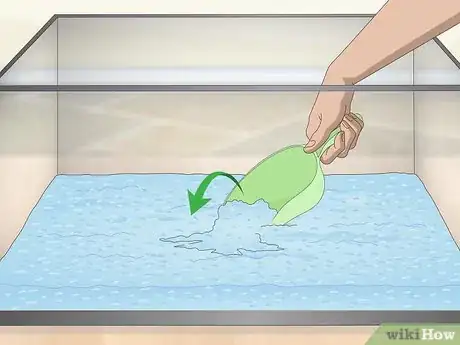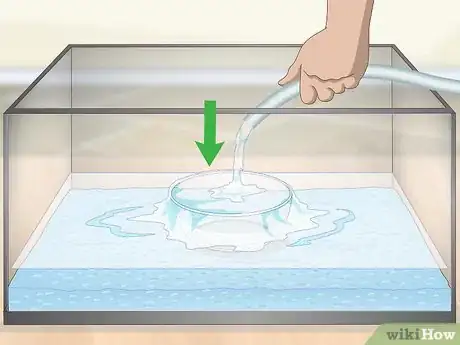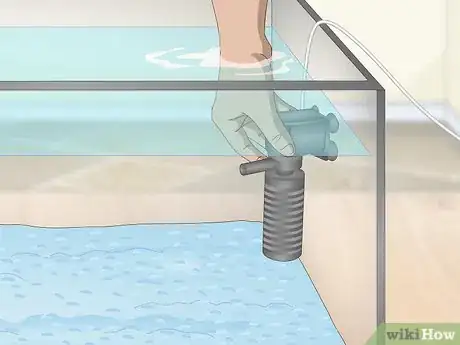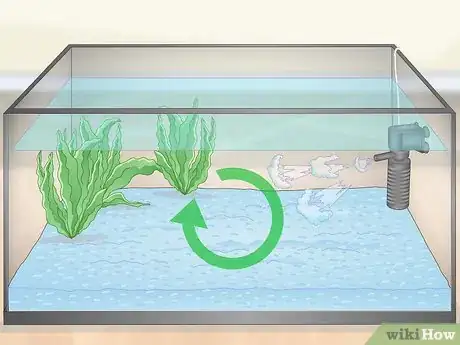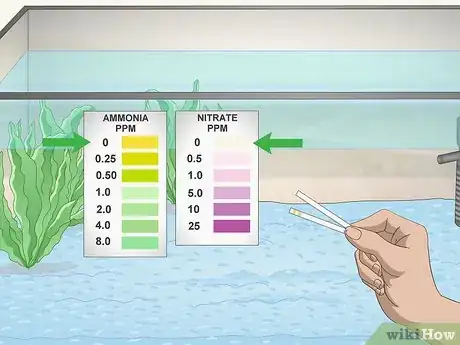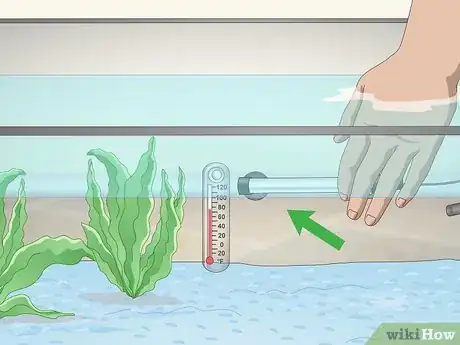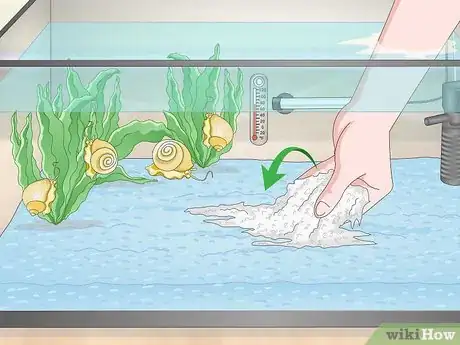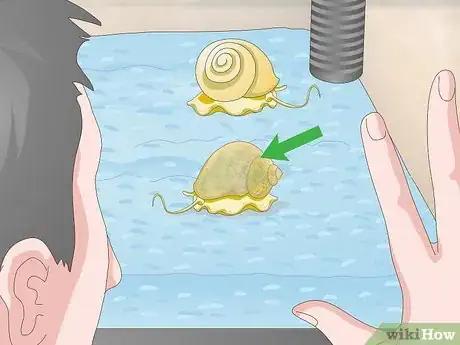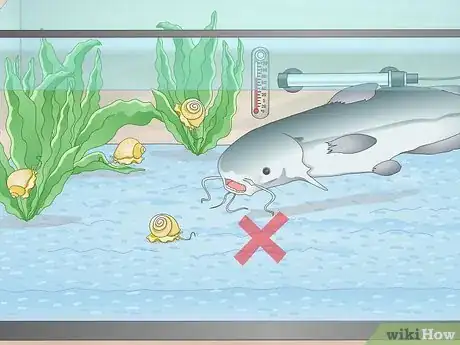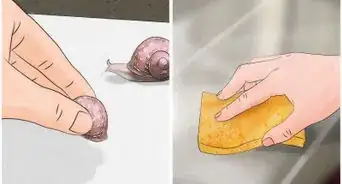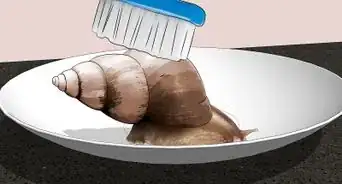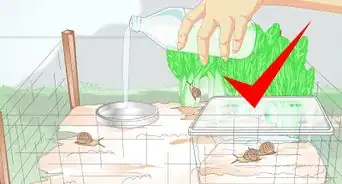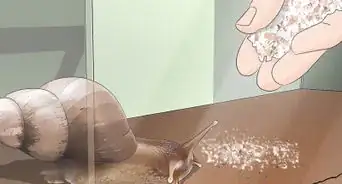This article was co-authored by wikiHow Staff. Our trained team of editors and researchers validate articles for accuracy and comprehensiveness. wikiHow's Content Management Team carefully monitors the work from our editorial staff to ensure that each article is backed by trusted research and meets our high quality standards.
This article has been viewed 41,393 times.
Learn more...
Whether you want a new addition to an already thriving freshwater aquarium or you're in search of a new, low-maintenance pet, an apple snail is a great choice. A species of aquatic snail that encompasses the mystery snail, the Golden Inca snail, and many others, the apple snail is an easy addition to any tank. By setting up a freshwater tank, feeding your snails, and giving them plenty of calcium, you can happily take care of some apple snails.
Steps
Setting up a Tank
-
1Purchase a 10 US gal (38 L) tank with a lid. Even though they are slow-moving creatures, apple snails will still need plenty of room to move around. Purchase a tank that is able to hold at least 10 gallons (38 L) of water and place it in a corner of your chosen room.[1]
- A 10 US gal (38 L) tank will be able to house around 3 to 4 apple snails. Each additional apple snail will need around 2.5 gallons (9.5 L) of space, as will any other fish or creatures you want to add to your aquarium.
- Keep your tank away from direct sunlight or strong breezes, as this may change the temperature of the water in your tank and make it uncomfortable for your snails. Also, set the tank up somewhere out of the way where it can be observed without being knocked around.
- Ensure there is at least 1 electrical socket nearby, as you’ll likely need it to power a heater and your tank filter.
- A tank holding 10 gallons (38 L) of water will be very heavy. Make sure it is sitting on something that can easily hold that weight.
-
2Cover the bottom of the tank with around 2 inches (5.1 cm) of gravel. Buy a bag of aquarium gravel or pebbles from your local pet store. Rinse them in a bucket or through a colander to clean away any dust, before carefully scooping them into the tank. Add enough gravel to form a layer on the bottom of the tank around 2 inches (5.1 cm) deep.[2]
- Make sure your gravel or pebbles are smooth so your snails don’t get hurt from sitting on them.
- Avoid painted rocks and pebbles, as these may contain chemicals that will be harmful to your snails and will often begin to flake after a few months.
- Use a small scoop or a bowl to lower the gravel or pebbles into the tank. If you pour the gravel in, it might scratch or damage the glass of your aquarium.
Advertisement -
3Fill the tank with water. Place a small bowl or plate on the bottom of your aquarium. Use a large jug or a garden hose to begin carefully filling your tank with clean, fresh water. Pour the water onto the bowl or plate so it can slowly pour off the sides. This way the water being poured in won’t disturb the gravel.[3]
- Make sure your aquarium is properly placed before you fill it with water, as it will become very heavy and difficult to move once it’s full.
-
4Decorate the aquarium with aquatic plants. Aquatic plants will help oxygenate the water of your tank, and decorations will give your snails something to look at and interact with. Plant a few aquatic plants, such as java moss or water wisteria, in the gravel at the bottom of your tank. Look online or at your local pet store to find some decorations for your tank as well.[4]
- Try and keep around 1/3 of your tank free from decorations and plants. This will give your snails plenty of room to move around freely, while still letting them interact with your decorations.
- Your snails may try to eat the plants you add to your aquarium. This may be a sign that you aren’t feeding them enough, but might simply be because your plants can be eaten. Try feeding your snails more food or more frequently to stop them from snacking on your plants. Otherwise, you may need to replace the plants more frequently, or with a variety that your snails leave alone.
-
5Add a filter to your tank. There are many different types of filters that you can add to your tank, but all of them will help balance the bacteria in the aquarium and keep your snails healthy. Purchase a tank filter online or from your local pet store and set it up in your tank according to the manufacturer’s instructions.[5]
- There are many different types of filters for tanks of all shapes and sizes. Research the different filters or ask at your local pet store for help in choosing the perfect filter for your home set-up.
-
6Leave your tank to cycle for 2 weeks. Doing a fishless cycle in your tank will let it safely build up the bacteria in the tank. Turn your filter on and let it run for at least 2 weeks, adding a small pinch of fish food each day to help balance the ammonia levels.[6]
- Don’t purchase any snails until you have left your tank to cycle for at least 2 weeks.
- Leaving your tank to cycle will allow the water in the tank to balance and make it safer for your snails when you add them.
-
7Check the pH levels of your water. Apple snails will thrive happily in slightly alkaline water with a pH level of around 7 to 8. Purchase a liquid pH test kit online or from your local pet store. Follow the manufacturer’s instructions to test the pH level of the water to make sure it’s in the safe range for your snails.
- If the pH level of your tank is less than 7, you can increase it by adding something basic such as baking soda.
- If the pH level of the aquarium is above 8, you can lower it by adding some driftwood.
- If you’re worried about the pH level of your water, purchase a pH regulator online or from your local pet store and install it in your tank.
-
8Test the water for ammonia and nitrite. The bacteria built up in your tank’s filter should help keep the levels of ammonia and nitrites very close to 0. Purchase an ammonia/nitrate test kit and follow the manufacturers’ instructions to check the levels of ammonia and nitrate in the water of your tank.
- If the ammonia and nitrate levels in your tank are too high and need to be lowered, replace 25% of the water in your tank and leave the filter to run for another day. Test it again to check the ammonia/nitrate levels and repeat until they are low enough for your snails to live comfortably.
-
9Add a heater and thermometer to the tank to regulate the temperature. Your apple snails will be most comfortable in water that is between 75 to 85 °F (24 to 29 °C). To make sure the water doesn’t get too cold, purchase an aquarium heater and thermometer. Install them in the tank and follow the manufacturer’s instructions to turn them on and begin regulating the temperature.[7]
- Let the heater sit in the aquarium water for at least 30 minutes before plugging it in and turning it on. Otherwise, the sudden shift in temperature could cause the heater to shatter.
- Make sure you install the heater with a drip loop. This is a loop in the cord that dips down before it reaches the wall socket. This will allow any water that runs down the cord to drip off onto the ground rather than going directly into the electrical socket and causing it to short-circuit.
-
10Place your snails on the bottom of the aquarium. Once your aquarium is set up and the pH level, ammonia/nitrate level, and the temperature are all in the comfortable range for your snails, you can pick them up and lower them into the tank. Place the snails on gravel bottom and leave them for 8 hours or overnight to adjust to their new home.[8]
- Your snails will be too busy getting used to their new tank that they won’t be ready to eat for at least 8 hours. Wait to feed your snails until at least 8 hours after you put them in the tank to avoid food sinking to the bottom and rotting.
Caring for Your Apple Snails
-
1Feed your snails with blanched vegetables each day. Snails will eat almost anything, but they particularly love slightly blanched vegetables. Finely dice a mix of shelled peas, carrot, cucumber, broccoli, cauliflower, zucchini, or iceberg lettuce and cook them very quickly in boiling water. Wait for them to cool before sprinkling a small handful into the water.[9]
- Feed your snails a small amount and make sure they consume all of it within 12 hours. Increase the amount of food you give them each day until they stop being able to eat all of it. Reduce the amount of food slightly and keep to that amount each day.
- If you notice food left at the bottom of the tank 12 hours after you feed your snails, scoop it out to prevent it from decomposing. If you notice this happening, reduce the amount you feed your snails in the next feeding.
-
2Add calcium to the water each week. Apple snails need additional calcium to be added to the water to help their tanks stay strong and healthy. Purchase some crushed sea shells, cuttlebone or shell grit online or from your local pet store. Add a small handful to your tank once a week to give your snails plenty of calcium.[10]
- Keep an eye on your snails’ shells. Any irregular growth or spots can be a sign that your snails aren’t getting enough calcium.
-
3Watch the snails’ shells for signs of illness. As they are quite small creatures, it can be very difficult to tell if your snails are staying healthy. Normally, a snail's shell will be the main sign that something is wrong. Keep an eye on your snails’ shells for any changes in color or irregular patterns that may indicate that they’re ill.[11]
- If you think your snail is ill, check the water quality to make sure it is still in the healthy ranges for apple snails.
- Check for white spots on your snail’s skin, which could be a sign that they have a parasite. Consult a vet or look online for more advice on diagnosing and treating parasites on your snail.
-
4Remove any snails that pass away. Even if you take great care of your snails, they will eventually pass away. If you notice that your snail has stopped moving for a few days, doesn’t stick to the tank, and begins to smell, lift it out of the tank and dispose of it safely.[12]
- You could bury your snail somewhere in your garden if you want to give it a nice burial. Otherwise, place it in a small container and put it in your trash can.
- Wear gloves when handling a snail that has begun to decompose, and wash your hands once you have finished with it.
-
5Avoid adding fish large enough to eat your snails. There are plenty of fish, such as guppies and platys, that will make for great tank mates for your snails. However, a bigger fish may see apple snails as tasty treats if they can fit one in its mouth. Don’t put any fish in the same tank as your apple snails that will be able to eat them.[13]
- Loaches and catfish are both very predatory fish that will love eating your snails. Never put them in the same tank as an apple snail.
Community Q&A
-
QuestionHow do snails give birth?
 Community AnswerSnails lay eggs. Be careful though, because they are tiny and will get stuck in your filter.
Community AnswerSnails lay eggs. Be careful though, because they are tiny and will get stuck in your filter. -
QuestionMy snail doesn't come up to the top of the tank. How should I feed him?
 XenaCommunity AnswerPut the food in his tank and leave him to eat in peace.
XenaCommunity AnswerPut the food in his tank and leave him to eat in peace. -
QuestionAre apple snails a saltwater species?
 Community AnswerApple snails cannot tolerate saltwater. It will kill them.
Community AnswerApple snails cannot tolerate saltwater. It will kill them.
Warnings
- Copper is toxic to snails and will make them very ill. Avoid adding anything metal to your tank to prevent your snails from getting ill.⧼thumbs_response⧽
- Don’t use sand or mud as a substrate for your snails. They won’t like living on the sand and will find it more difficult to get nutrients from it.⧼thumbs_response⧽
References
- ↑ http://meethepet.com/apple-snail-ampullariidae/
- ↑ https://aquariuminfo.org/beginner.html
- ↑ https://aquariuminfo.org/beginner.html
- ↑ https://aquariuminfo.org/beginner.html
- ↑ https://aquariuminfo.org/beginner.html
- ↑ https://aquariuminfo.org/beginner.html
- ↑ http://meethepet.com/apple-snail-ampullariidae/
- ↑ http://meethepet.com/apple-snail-ampullariidae/
- ↑ https://aquariuminfo.org/applesnail.html
About This Article
To take care of an apple snail, keep it in a 10-gallon tank that's filled with 2 inches of aquarium gravel or pebbles. Then, fill the tank with clean water, and bury a few aquatic plants in the gravel, like java moss or water wisteria. Next, hook up a filter to help keep the water clean, and set up a heater so you can keep the temperature between 75 and 85 degrees Fahrenheit. Finally, let the tank cycle for 2 weeks before introducing your apple snail to it. To learn how to feed and care for an apple snail, scroll down!

